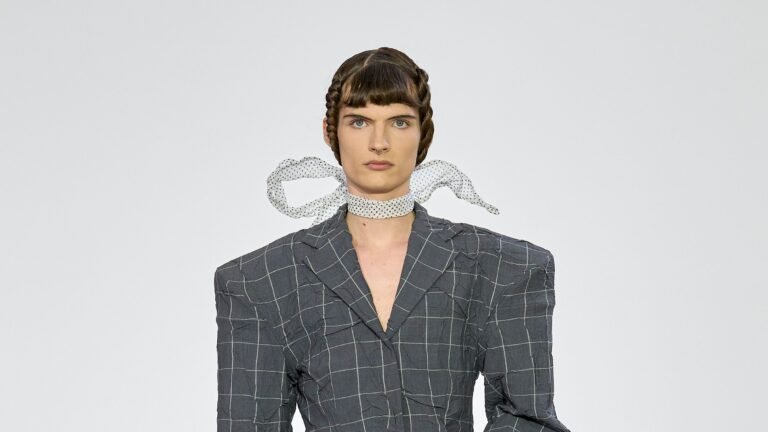Rave Review’s Josephine Bergqvist and Livia Schück lived up to their green credentials this season by bringing their designs from Stockholm to Copenhagen by train. It’s the first time the two have been back on the calendar here since 2020. More recently these Swedes have been showing in Milan, where their work, with its DIY aesthetic, felt a bit lost. As Rave Review has always worked with vintage and deadstock materials, the brand’s values seem more aligned with those of Copenhagen Fashion Week.
With the new location came new vibes. In recent seasons the RR offering had started to feel formulaic, but that feeling was dispelled with the opening look, which featured a geometric jacket with shoulders of David Byrne proportions, its gray check contrasting with a ditsy-print skirt. The designers’ reference point was not the Talking Heads’ frontman, however, but the traditional Dutch tulip festival dress, Volendamse klederdracht.
The headscarves and aprons that are part of that get-up read simply as boho, and the sensibility was one of a slightly sexed-up summer idyll. The designers spend a lot of time between the sheets—meaning they love and often work with patterned bed clothes. For spring they fused these fabrics; the result was textural perma-wrinkles. “I was happy when I found this way to work with the fabric because bed linen is so beautiful, but it’s also so flat,” noted Bergqvist. She took the lead this season because Schück has just had a baby.
Cutting through space sharply were the extended shoulders that appeared throughout the collection, their width created either through construction or boning. The latter was also used to broaden hips. The linear quality of these silhouettes–as well as the use of stripes—complemented the brand’s signature spiral cuts (which prevent fabric waste) and bubble hems.
Berquist described the collection as “true to ourselves, we are always drawn to the same kind of aesthetics in a way,” but the structure and closeness to the body of some of the pieces was a step forward for the duo. They called the show Blommornas Makt, which translates as Power of Flowers, a concept distinct from flower power and its hippie connotations. Still, the ’60s did figure into things, as one of the references was Mah-Jong, a Swedish feminist fashion collective from that era who believed that clothes should adapt to different body types and “should be allowed to be pretty.” This gives context to Bergqvist’s statement that the collection was “about the meaning of the flower, just quite literally,” by which she seemed to suggest that in an ugly world, beauty is a sign of resistance.
